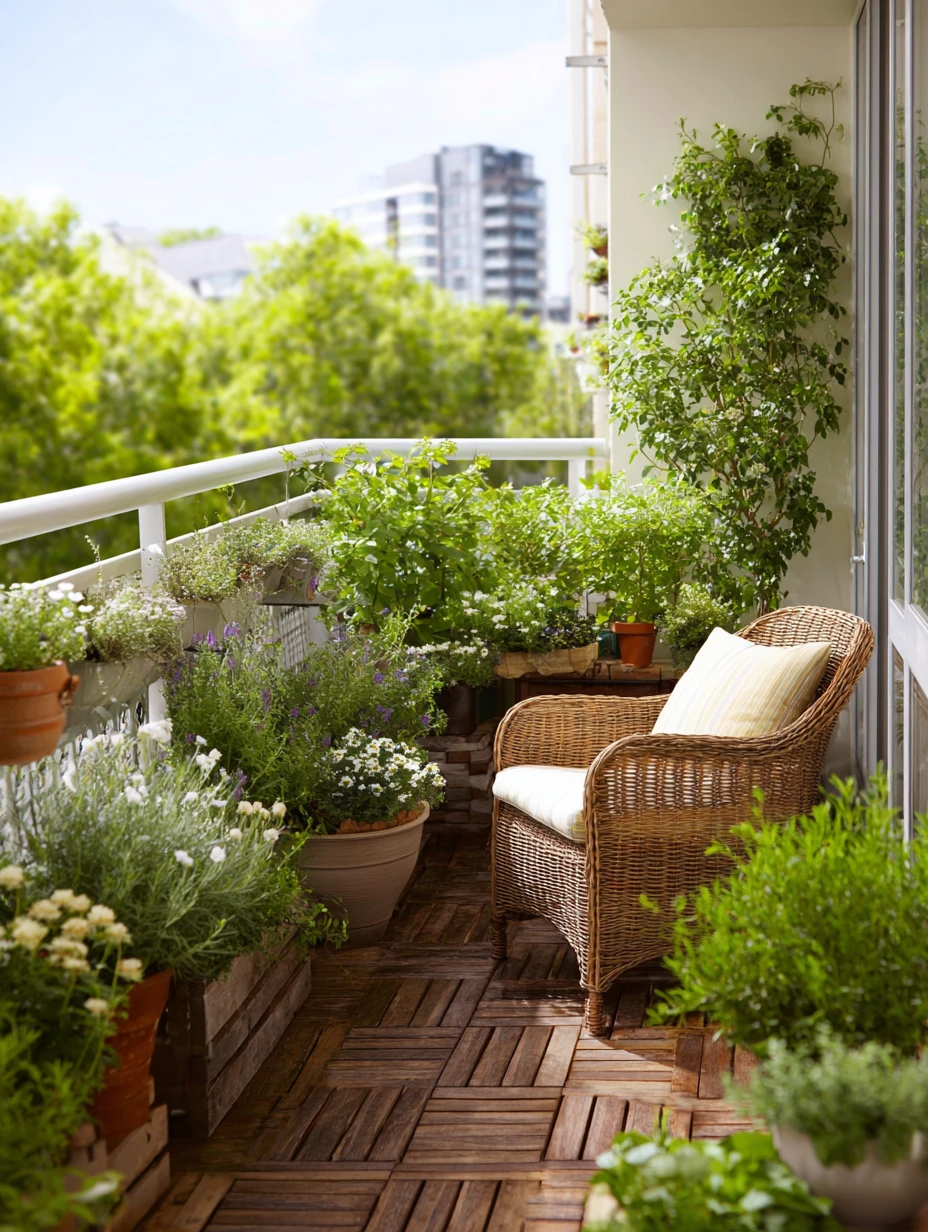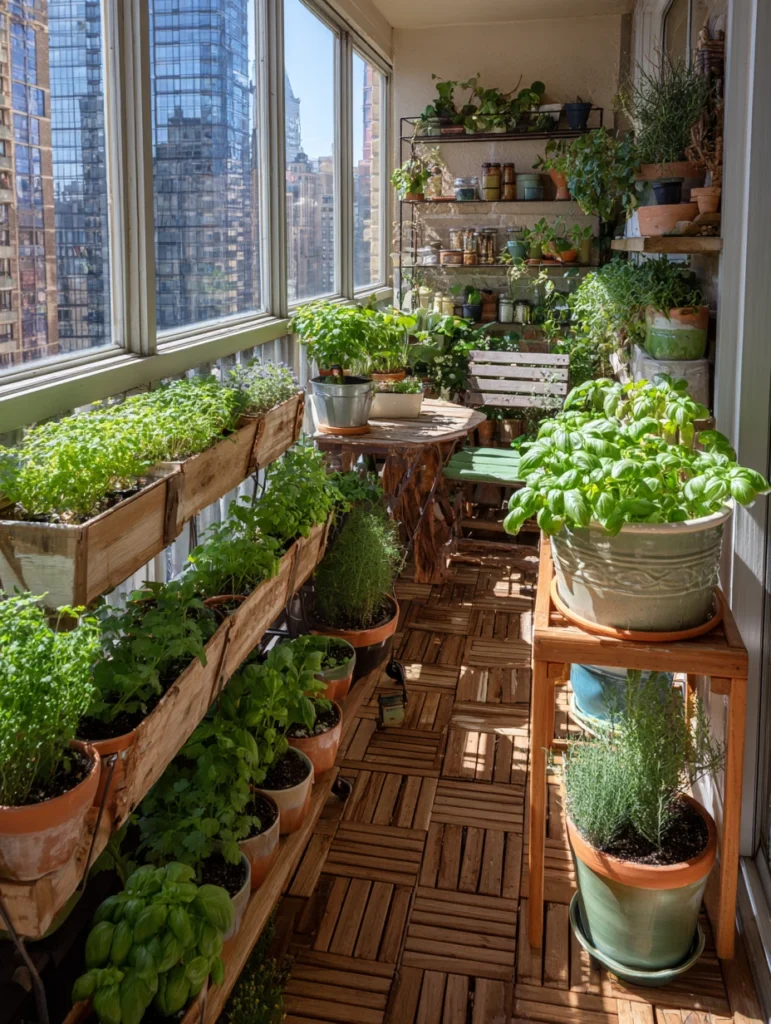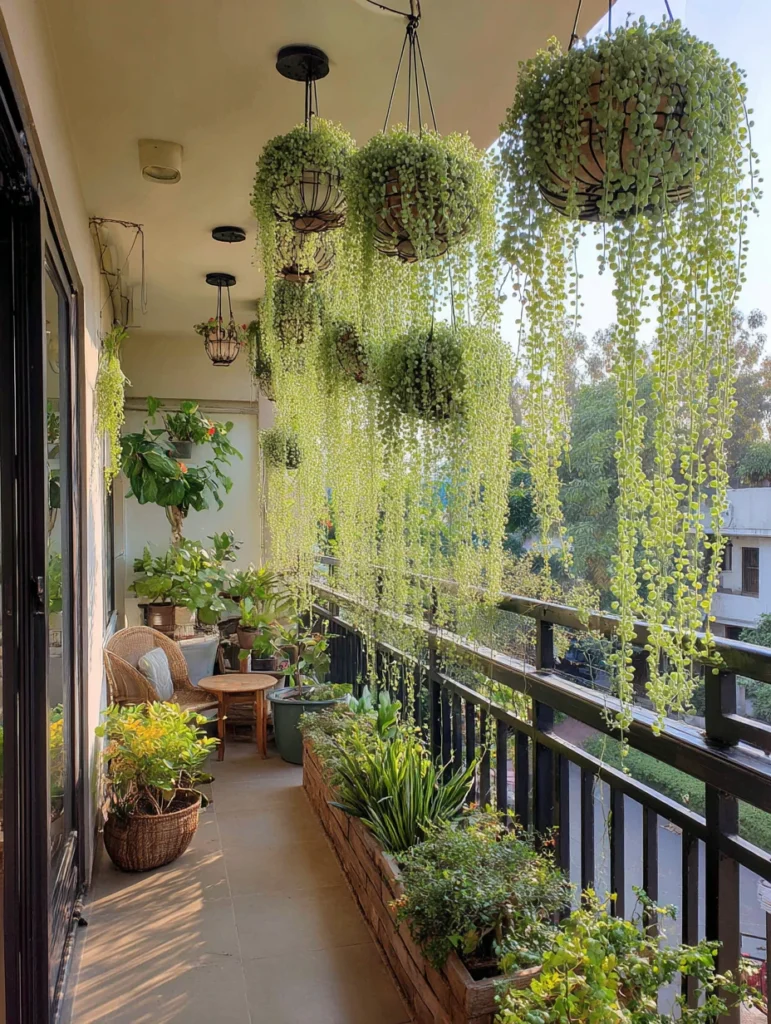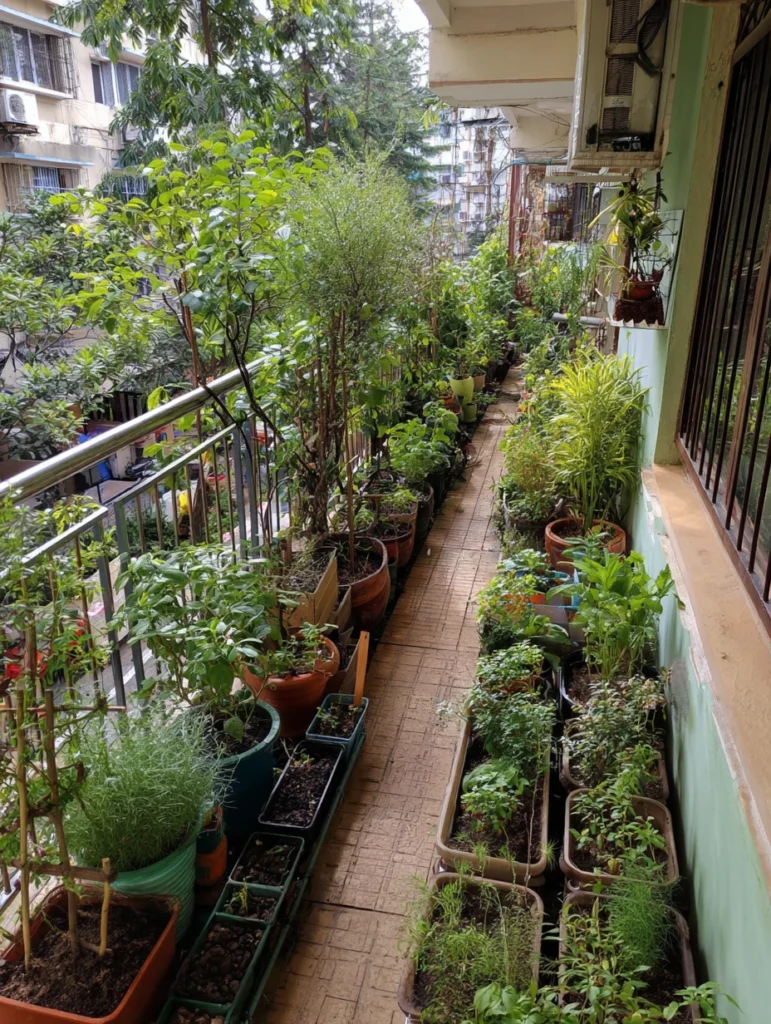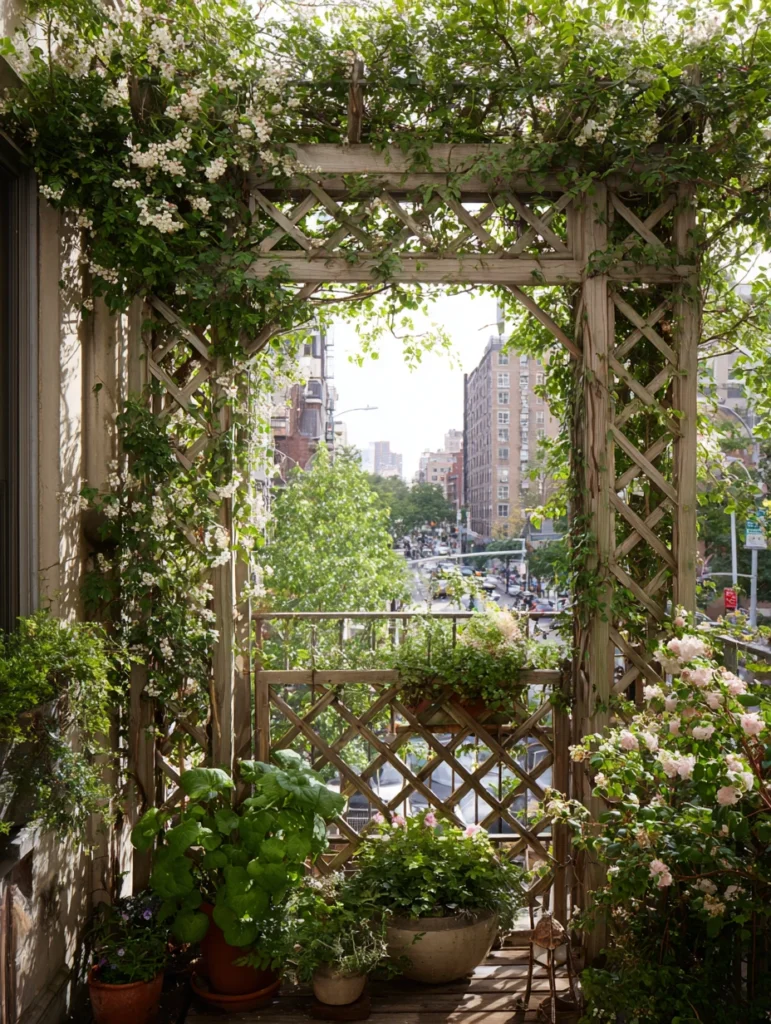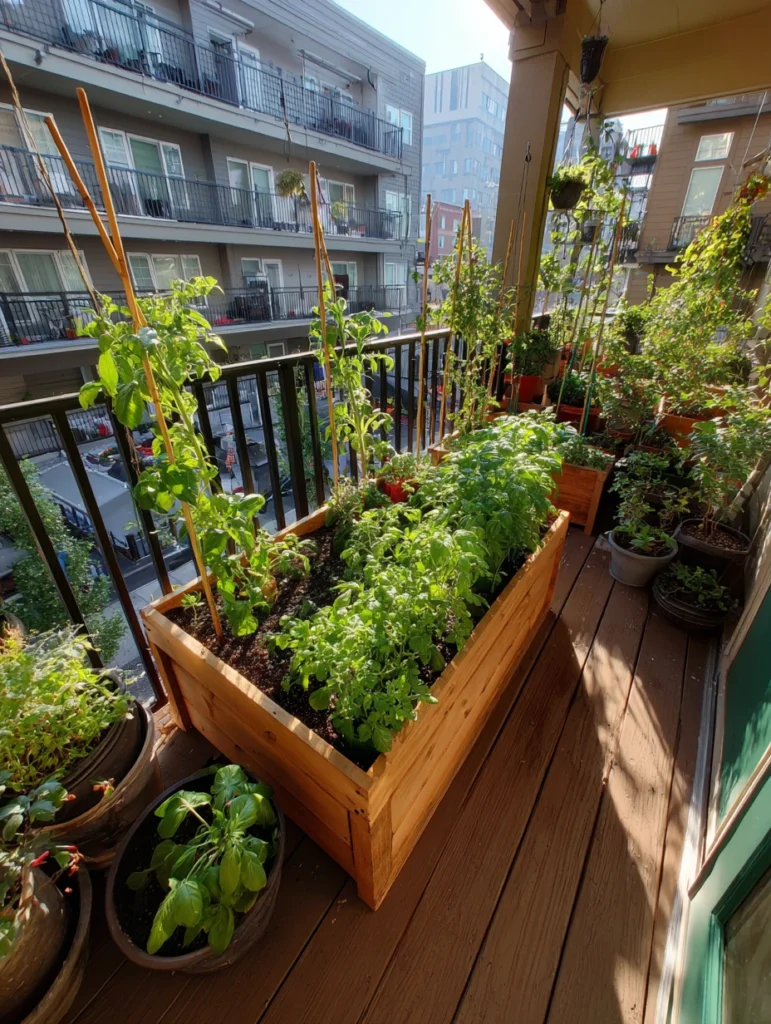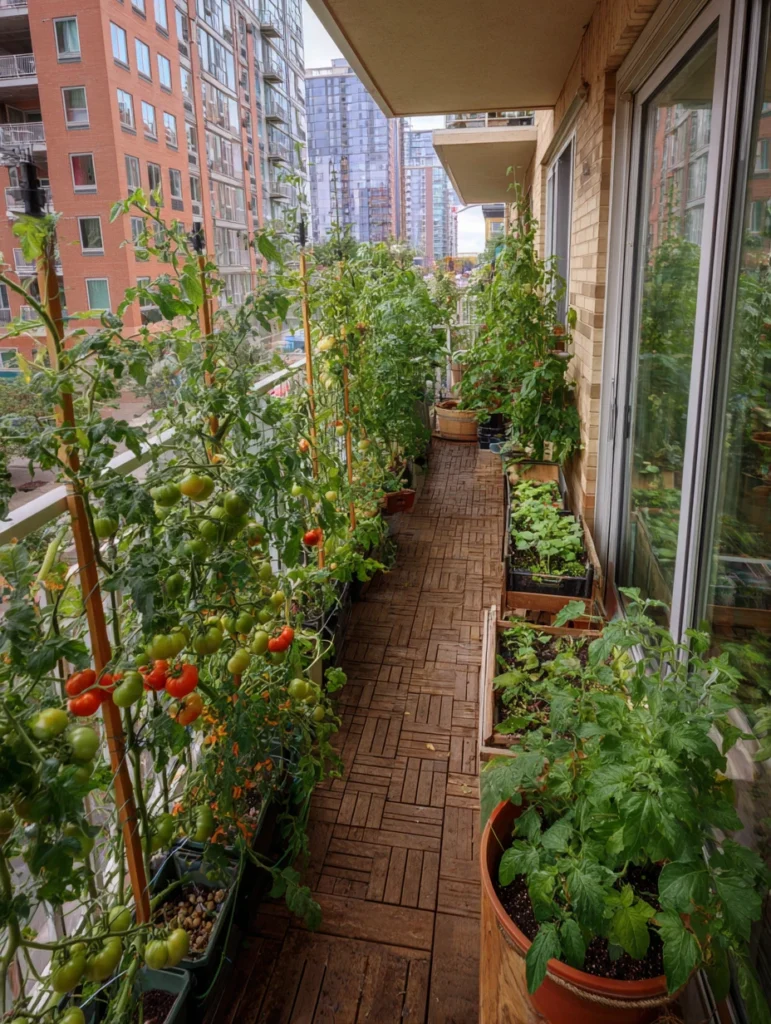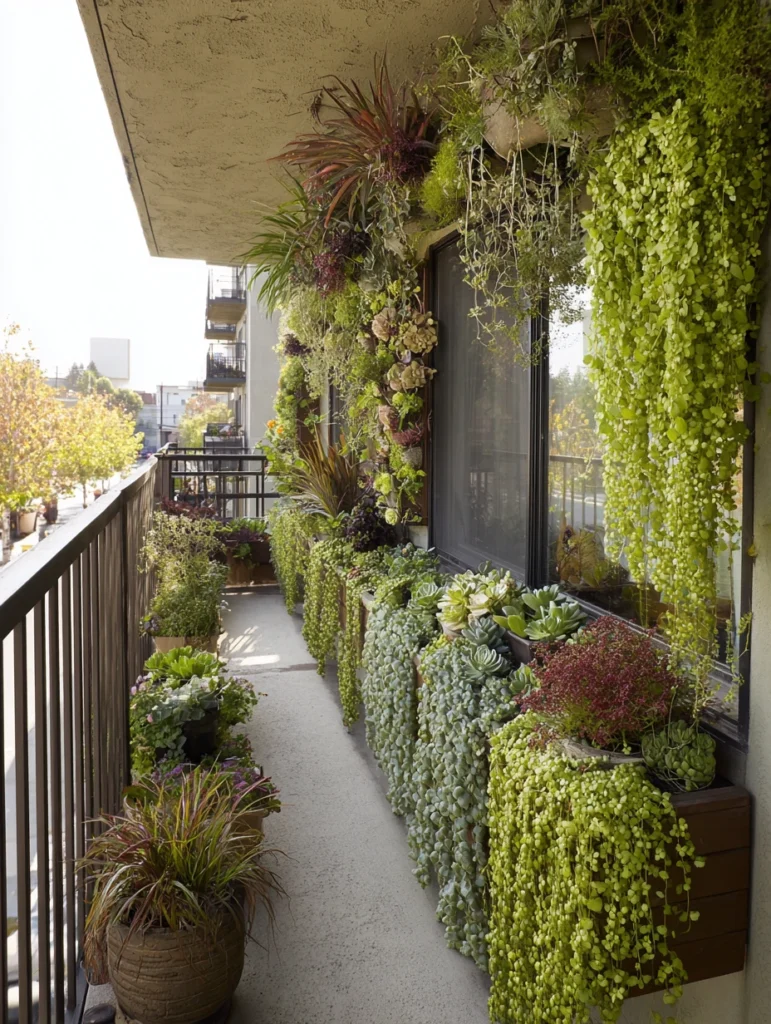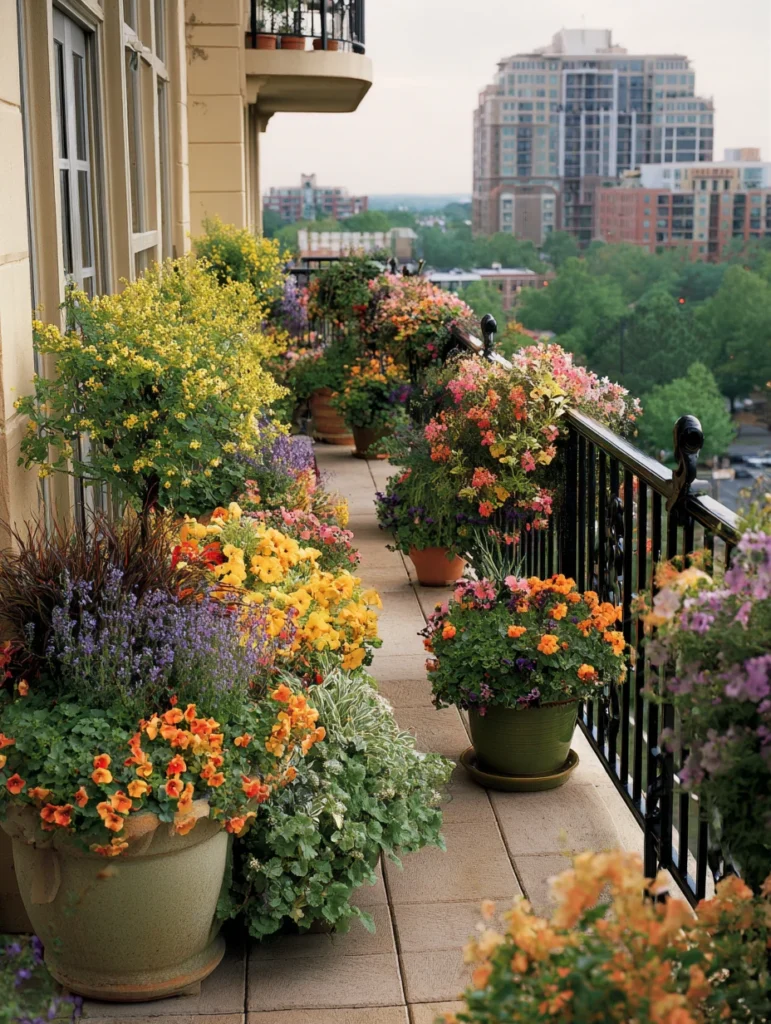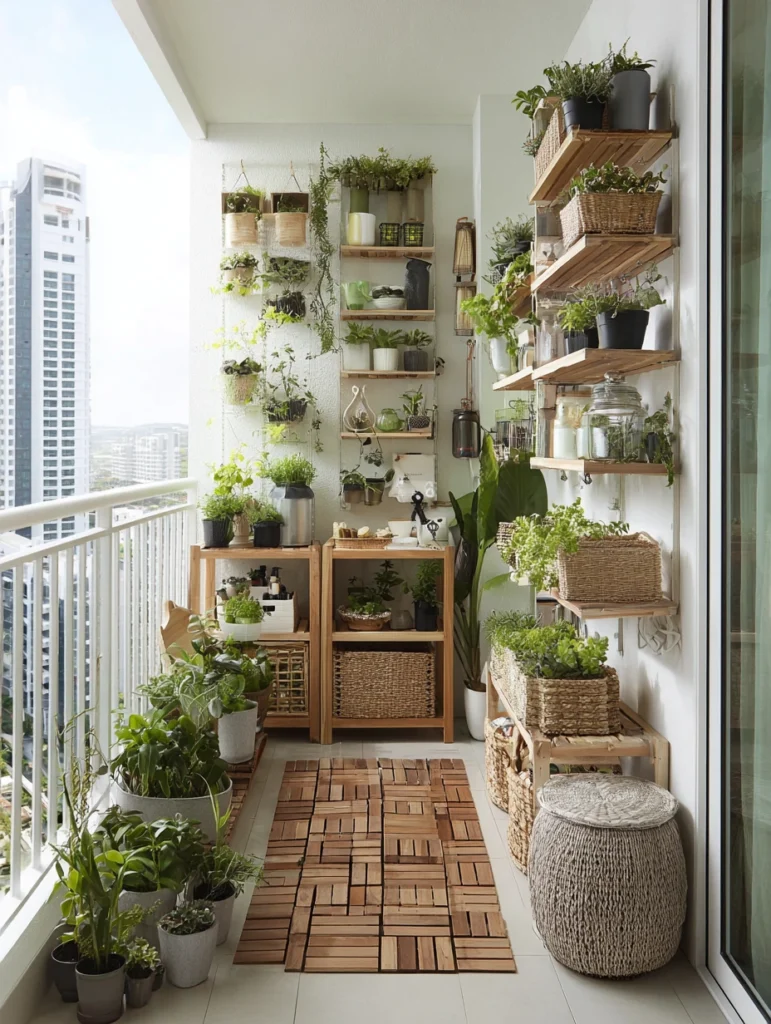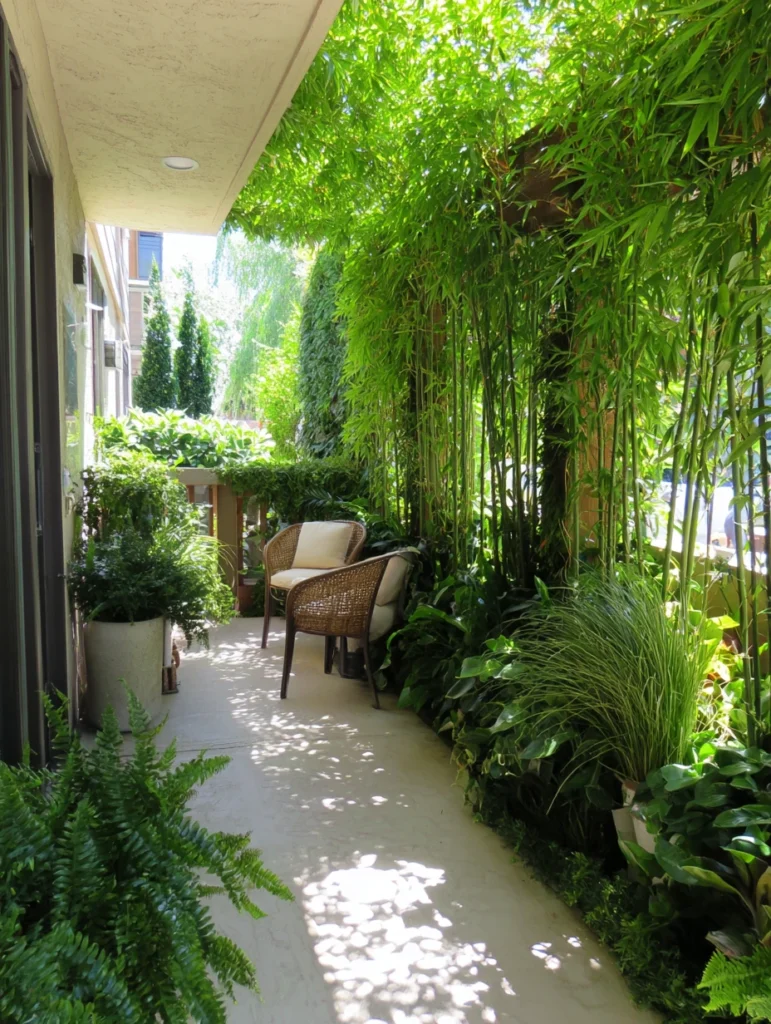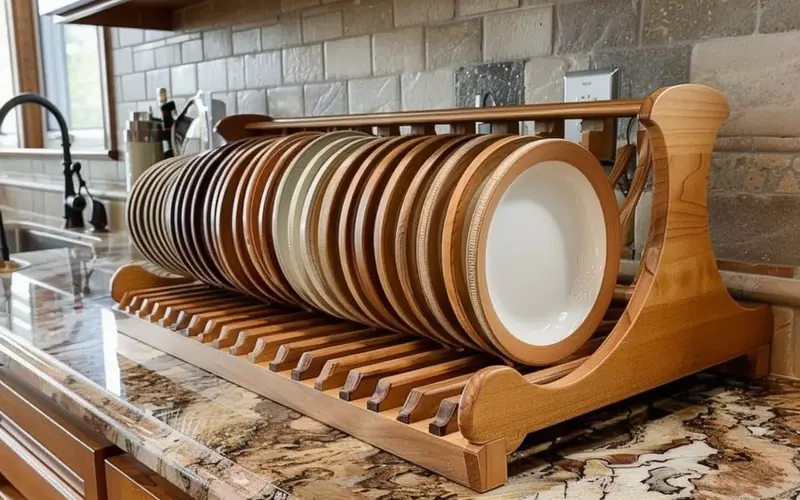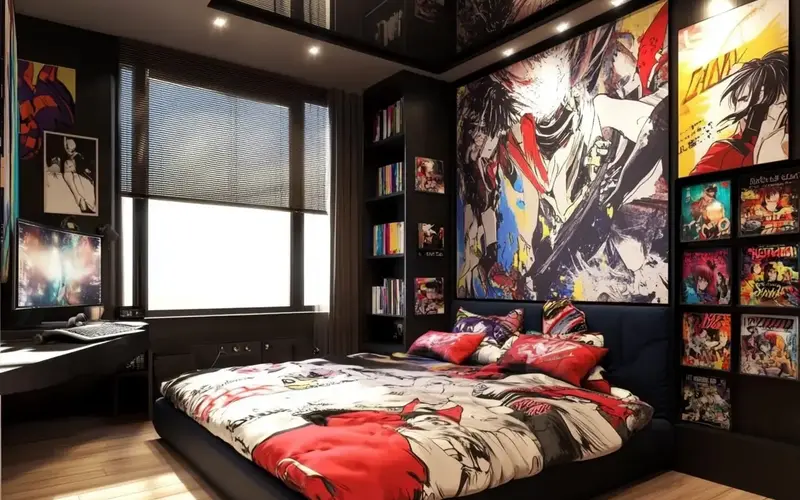Your tiny balcony doesn’t have to stay empty or dull. In fact, balconies are seriously underrated spaces that can transform into your personal green sanctuary. Whether you’re a seasoned gardener or someone who’s killed a cactus before (no judgment here), there’s absolutely something in this list that’ll work for your space.
We’re talking about turning that cramped corner into a lush, vibrant retreat where you can actually relax and feel like you’ve escaped the city chaos. Let’s explore some practical, creative, and downright fun ways to bring your balcony garden to life.
1. Vertical Wall Gardens
Why Vertical Works: The beauty here is that vertical gardening draws the eye upward, making your space feel larger and more intentional. Additionally, you’re maximizing sunlight exposure, and plants actually receive better air circulation when they’re not crowded on the ground. And have you ever wondered why plants in vertical setups seem healthier? It’s partly because water drains more effectively and pests have a harder time establishing themselves.
Installation Tips: Begin with lightweight materials and ensure that your balcony railings or walls can support the weight. Concrete walls are ideal – you can use adhesive hooks or heavy-duty fasteners. If your wall isn’t concrete, check your rental agreement first (because, yeah, not everyone gets to drill into walls). Begin with one small section to test the setup before going full vertical forest mode.
Product Spotlight: The Wall-Mounted Plant Hanger with Pockets and Metal Grid Plant Wall Frame provides everything you need to get started, eliminating the need for complicated installation or special tools.
Read More: 21 Inspiring Vegetable Garden Design Ideas
2. Container Gardening with Herbs
Choosing Your Containers: Size matters more than aesthetics here (though your containers can also look nice). Herbs need at least six inches of depth, so avoid trying to squeeze them into shallow decorative pots. Drainage holes are non-negotiable; they prevent root rot, which is essentially the silent killer of container plants. Dark-colored containers absorb more heat, which herbs actually appreciate, especially in cooler climates.
Spacing and Care: Space your containers about six inches apart to ensure each plant receives adequate airflow and is not competing for sunlight. Water when the top inch of soil feels dry to the touch – this usually means daily watering during hot months. Pinch off the flowers on herbs like basil to encourage bushier growth and prevent bolting (when they become slender and start flowering prematurely). Your herbs will reward you with lush growth and flavors that absolutely crush anything from the grocery store.
Product Spotlight: Elevate your gardening experience with a Self-Watering Herb Planter Set and a Ceramic Herb Pot Collection featuring drainage to help your herbs thrive without the daily watering stress, especially on busy days.
Read More: 21 Small Zen Garden Ideas for a Tranquil Home
3. Hanging Planters for Greenery
Choosing the Right Plants: Trailing plants are the stars of hanging situations because they naturally grow downward, creating a gorgeous waterfall effect. These plants are typically pretty low-maintenance, but they do need consistent moisture and indirect light in most cases. Succulents work too if you prefer something heartier that tolerates dry spells. The key is matching the plant’s light and water needs to your balcony’s conditions.
Installation Essentials: Use sturdy hooks that can support the weight of wet soil and plants – this is not the time to skimp on hardware. Install hooks into structural elements, such as ceiling beams or solid railings. Ensure that whatever you install can support at least twice the weight you anticipate needing. Test it gently before fully committing that expensive plant to it. Hanging planters dry out faster than those at ground level because they receive air exposure on all sides, so you may need to water them more frequently.
Product Spotlight: The Macramé Plant Hanger with Ring Holder and Ceramic Hanging Planter with Saucer provide both style and function, keeping your trailing plants secure while looking effortlessly beautiful on your balcony.
Read More: 21 Cottage Garden Ideas for a Whimsical Space
4. Tiered Plant Stands
Maximizing Plant Display: Tiered stands work best when you arrange plants by height – taller ones on the bottom tier and shorter specimens on top. This way, each plant gets proper light and water without larger plants shading out the smaller ones. You can also play with different types of plants at various levels, mixing flowering plants with foliage for visual variety. The layered effect creates depth, making your balcony garden look more intentional and well-designed.
Stability and Safety: Weight distribution matters here, especially if you’re on a balcony with wind exposure. Put heavier pots on lower tiers and lighter hanging baskets on top. Ensure your stand won’t tip over if someone leans on it – stability should be your top priority. Position the stand against a wall or in a corner if possible to minimize wind impact. If you’re in a particularly windy area, consider tethering it slightly to a railing for extra security.
Product Spotlight: Invest in a Bamboo Plant Stand with 3 Tiers and a Metal Corner Plant Stand that’ll hold your growing collection while looking intentional and professional in your space.
Read More: How to Design a Container Garden for Your Flowers
5. Drip Irrigation Systems
System Setup: Basic drip systems typically include a timer, a main hose line, and smaller drip lines that connect to individual pots. You can pick up simple kits online and set them up in under an hour. Connect it to your balcony faucet or water source, program the timer for early morning or evening watering, and you’re done. The beauty is that you’re not wasting water by spraying leaves – the water goes directly into the soil, where plants actually need it.
Benefits Beyond Convenience: Consistent moisture means fewer problems with wilting, yellowing leaves, and stressed plants. You’ll also reduce fungal issues that come from wet foliage and inconsistent watering cycles. Plants grow better when they’re not fluctuating between dry and damp conditions. Over time, you’ll notice that your plants are happier, fuller, and more vibrant than when you were watering them randomly by hand.
Product Spotlight: The Automatic Drip Irrigation Kit with Timer and Adjustable Drip Emitter Hose Set allows you to set up a worry-free watering system that keeps your balcony garden thriving, even when life gets hectic.
Read More: Amazing Herb Garden Ideas for Your Outdoor Oasis
6. Trellis Designs for Climbing Plants
Plant Selection for Trellises: Choose climbers based on your climate and light conditions. Some prefer full sun while others thrive in partial shade. Flowering vines add color and fragrance, while evergreen climbers provide year-round foliage. Most climbing plants require some support during their early growth phase; tie them gently to the trellis using soft string or plant ties as they establish. Once they get going, they’ll naturally latch onto the structure.
Trellis Styles and Materials: Wood trellises have a warm, natural feel but require occasional maintenance to prevent rot. Metal trellises are more durable and well-suited for modern spaces. You can also use simple wooden stakes arranged in patterns for a more budget-friendly option. The style you choose should complement your balcony’s overall aesthetic while being sturdy enough to handle mature plant growth. Make sure whatever you choose is securely fastened so that the wind doesn’t topple it over.
Product Spotlight: Enhance your outdoor space with a wooden garden trellis featuring a lattice design. Create stunning vertical support structures that transform your balcony into a lush green oasis with style, using an Expandable Metal Trellis Panel and a Wooden Garden Trellis with a Lattice Design.
Read More: 21 Corner Garden Ideas to Transform Your Backyard
7. Raised Garden Beds
Building Your Bed: Use untreated wood or composite materials that won’t leach chemicals into your soil. Dimensions don’t have to be huge – even a 2×2 foot bed gives you space for multiple plants. Line the bottom with landscape fabric to prevent soil from washing through cracks while still allowing water drainage. Fill with quality potting soil mixed with compost, and you’ve got an instant garden bed that’ll outperform shallow containers.
What to Grow: Raised beds work great for vegetables, cutting flowers, and smaller shrubs. Lettuce, spinach, tomatoes, and peppers do fantastically in balcony beds. You can also create a cutting garden for flowers that look amazing in arrangements. The deeper soil in raised beds allows for better root development compared to the shallower soil in containers. Rotate your crops seasonally to maintain healthy soil and prevent the buildup of pests.
Product Spotlight: Select a Composite Raised Garden Bed Kit and Landscape Fabric with Stakes to create a professional-looking vegetable garden that maximizes your balcony space and yields real food.
Read More: Stunning Flower Bed Ideas for the Front of the House
8. Succulent Arrangements
Arrangement Principles: Mix different succulent varieties for visual interest by combining tall, architectural plants with trailing varieties and colorful rosettes. The contrast makes arrangements more dynamic than planting all the same type. Use well-draining succulent soil to prevent root rot, which is the primary cause of death for these otherwise resilient plants. Pack them somewhat snugly in containers so they support each other as they grow.
Seasonal Color Shifts: Many succulents change color in response to temperature and light fluctuations, often turning purple, red, or orange when the temperature drops or the sun shines. This means your arrangement naturally evolves throughout the year without requiring any special action on your part. It’s like getting a new display without any effort. During winter dormancy, most succulents need less water, so you can basically ignore them while they chill and prepare for spring growth.
Product Spotlight: Grab a Mixed Succulent Assortment Pack and Decorative Concrete Planter Set to create stunning, virtually maintenance-free displays that look impressive and require minimal daily attention.
Read More: 21 Magical DIY Fairy Garden Ideas for Your Backyard
9. Window Box Gardens
Installation and Security: Ensure your window boxes are securely installed so they don’t fall onto anyone below (a crucial safety detail). Use sturdy brackets rated for the weight of wet soil and plants. Ensure that drainage holes are present in the bottom – water needs to escape so plants don’t become waterlogged. Install boxes where they’ll receive adequate light for your chosen plants, typically at least four to six hours of light for most flowering plants.
Planting and Maintenance: Layer drainage material at the bottom, add potting soil, and arrange plants so taller ones are in the center and trailing varieties cascade over the edges. Water the window boxes regularly, as they dry out quickly due to sun exposure and wind. Deadheading spent flowers encourages more blooms throughout the season. In colder climates, you might swap out summer annuals for winter pansies or evergreen foliage.
Product Spotlight: Use a Metal Window Box Planter with Brackets and Window Box Liner and Insert System to create an attractive, functional growing space that requires minimal maintenance while looking effortlessly charming.
Read More: How To Create a Beautiful Rose Garden To Inspire You
10. String Light Combinations with Plants
Design Combinations: Drape lights above or around your plant arrangements to create layers of visual interest. Avoid placing lights too close to plants to prevent heat damage to foliage. String lights work particularly well with climbing plants trained up a trellis – you can weave lights through the structure for a restaurant-like effect. Solar-powered string lights are practical for balconies where you don’t want to deal with extension cords.
Practical Considerations: Choose weatherproof, outdoor-rated lights that can withstand balcony conditions without deteriorating. Most modern string lights are designed to last several seasons without issues; however, it’s essential to check the ratings before making a purchase. Position lights where they won’t create glare if you have windows into your space. The combination of plants and gentle lighting makes your balcony feel like a genuine destination rather than just a functional space.
Product Spotlight: Invest in Outdoor Solar-Powered String Lights and Waterproof LED Garden Light Strips to create an enchanting atmosphere while ensuring your plants look stunning both day and night.
Read More: 21 Japanese Garden Ideas for Serene Outdoor Spaces
11. Pallet Garden Shelving
Sourcing and Preparation: Obtain pallets from local stores or warehouses; many offer them for free. Inspect carefully for chemical treatments or damage before using them. Sand down rough edges to prevent splinters, and you could paint or stain them for a more polished look. Lean them securely against your railing or wall to prevent tipping, and don’t overload them with heavy plants on the upper tiers.
Maximizing Space: Each pallet creates multiple shelves for arranging pots of different sizes. Group plants by water needs on the same shelf, allowing you to water them together efficiently. Use the space between slats for small potted herbs or trailing plants that cascade through the gaps. Pallets work particularly well for organizing a large number of small containers in a vertical arrangement.
Product Spotlight: Pair your pallet with Stackable Plastic Planter Pots and Heavy-Duty Plant Shelf Risers to create a sturdy, flexible shelving system that works perfectly for rental balconies and tight spaces.
Read More: 21 Stunning Mediterranean Garden Ideas To Inspire You
12. Compact Vegetable Growing
Container Sizes: Most vegetables require at least 12 inches of depth, although larger plants, such as tomatoes and peppers, benefit from 16 to 18 inches of depth. Use high-quality potting soil; garden soil tends to compact too much in containers. Space containers are arranged appropriately so that each plant receives adequate sunlight and air circulation. Crowding plants leads to disease and reduced productivity.
Support and Care: Tomatoes and peas need stakes or cages for support as they grow. Pinch off lower leaves on tomatoes to improve air circulation and prevent fungal issues. Consistent watering is crucial – vegetables are thirstier than ornamental plants. Feed regularly with a balanced fertilizer every two weeks, as container plants tend to exhaust nutrients faster than those in garden soil. You’ll be amazed at how productive a tiny balcony can be when you prioritize the right varieties.
Product Spotlight: Get a Container Vegetable Gardening Kit with Seeds and Tomato Cage and Stake Support System to start growing fresh vegetables that’ll make you wonder why you ever bought them from the store.
Read More: 21 Stunning Italian Garden Ideas That Bring Tuscan Beauty
13. Flower Arrangement Ideas
Cutting Technique: Use sharp scissors or pruners to make clean cuts that help flowers last longer in arrangements. Cut in the early morning when stems are hydrated. Remove the lower leaves that would sit below the waterline in your vase; this prevents bacterial growth, which can shorten the life of your flowers. Fresh flowers from your own balcony always beat store-bought bouquets.
Sustainable Blooms: Growing your own cutting flowers means no pesticides on the flowers you’re bringing into your home. You control exactly what touches them from seed to arrangement. The satisfaction of arranging flowers you grew yourself is genuinely hard to beat. Plus, you’re saving money compared to regular flower purchases while supporting your local ecosystem by planting native flowering varieties.
Product Spotlight: Use the Cut Flower Plant Variety Pack and Floral Arranging Tools and Vase Collection to create stunning fresh arrangements that celebrate your balcony garden while filling your space with natural beauty.
Read More: How To Create an English Cottage Garden for Your Flowers
14. Shade-Loving Plant Selection
Plant Options: Ferns are absolute superstars in shade with delicate, feathery foliage that moves gently. Hostas create an architectural structure with large, colorful leaves. Coleus offers an incredible color variety, even without direct sunlight. Impatiens and begonias flower reliably in shade, adding pops of color. Shade plants often prefer more consistent moisture compared to those in sun-baked containers, so keep the soil evenly moist but not waterlogged.
Creating Depth in Shade: Layer different heights and textures to make shade areas enjoyable. Combine upright plants with trailing varieties and a variety of foliage colors. Light-colored leaves help brighten shady spaces and make foliage more visible. Shade actually reduces pest problems, as many pests prefer full sun. By choosing shade-appropriate plants, you’re working with nature.
Product Spotlight: Grab a Shade-Loving Plant Mix Pack and Decorative Planter for Low-Light Environments to Transform Your Shaded Balcony into a Lush, Verdant Retreat That Actually Thrives Without Constant Sunlight.
Read More: 21 Aesthetic Garden Ideas to Transform Your Outdoor Space
15. Decorative Pot Choices
Material Considerations: Terra cotta is breathable and traditionally appealing, but it is prone to chipping. Plastic is lightweight and affordable, but doesn’t age as gracefully. Ceramic offers durability and style. Concrete provides modern, architectural vibes. Each material affects how quickly soil dries – terra cotta dries faster, while glazed ceramics retain moisture longer. Pick materials that match your plant’s water needs and your design preferences.
Sizing Strategy: Pots should be only slightly larger than the plant’s root ball – too much extra soil holds moisture and promotes root rot. Ensure that every pot has drainage holes, as waterlogged roots are the leading cause of plant death. Color your pots intentionally – lighter colors keep the soil cooler in hot climates, while darker pots warm the soil in cooler regions. Group similar pots together for cohesion or mix them for eclectic, collected-over-time vibes.
Product Spotlight: Invest in a Ceramic Planter Collection with Multiple Sizes and a Terracotta Pot Set with Drainage Holes to build a versatile collection that looks intentional while supporting healthy plant growth.
Read More: 21 Beautiful Scottish Garden Ideas Inspired by the Highlands
16. Water Feature Integration
Feature Options: Self-contained fountains plug in and recirculate water without requiring constant refilling. Birdbaths serve double duty as art and wildlife hospitality. Small pond containers (like half-barrel planters filled with water) create miniature ecosystems. Water features attract birds, bees, and butterflies that pollinate your plants, providing entertainment in the process.
Maintenance Needs: Most water features need regular cleaning to prevent mosquito breeding. Change water regularly or use mosquito dunks if you’re concerned. Position features where they’ll get adequate sunlight if you’re using plants in the water. The sound of gently moving water makes your balcony feel more peaceful and resort-like, making it worth the minimal maintenance required.
Product Spotlight: Choose a Self-Contained Tabletop Water Fountain and Ceramic Birdbath Planter to add dynamic elements that bring life and movement to your balcony while creating a sanctuary for visiting wildlife.
17. Railing Planters
Installation Safety: Use sturdy railing planters rated for your balcony’s weight capacity. Secure them well so they won’t tip with wind or movement. Ensure they’re installed low enough so that they won’t hit you or block your view completely. Check your rental agreement – some landlords restrict what you can attach to railings.
Plant Selection: Trailing succulents, ivy, and flowering cascaders, such as calibrachoa, work beautifully in railing planters. These plants create an instant living wall effect while keeping your balcony floor clear for walking. Railing planters dry out quickly due to their exposed soil, so check them regularly and water them accordingly. The hanging effect makes your balcony feel more garden-like and intentional.
Product Spotlight: Use Adjustable Railing Planters with Clips and Heavy-Duty Railing Planter Boxes to create a vertical garden that maximizes your space while maintaining safety and visual appeal.
18. Mixed Container Gardens
Composition Basics: Start with a thriller – a tall or upright plant in the center. Add fillers – medium plants that provide bulk and texture. Finish with spillers – trailing plants that cascade over the edges. This thriller-filler-spiller approach consistently creates balanced and interesting arrangements. Select plants with similar water and light requirements to simplify maintenance.
Planting and Maintenance: Use a large pot with excellent drainage —this is crucial. Layer drainage material at the bottom, then add potting soil. Arrange plants before fully planting so you can adjust positioning. Water thoroughly after planting, then maintain consistent moisture without waterlogging. Pinch off flowers and growth as needed to keep your desired shape throughout the season.
Product Spotlight: Grab a Large Mixed Container Garden Kit and Premium Potting Soil Blend to create stunning, Instagram-worthy arrangements that look professionally designed while being surprisingly easy to maintain.
19. Seasonal Plant Rotation
Seasonal Switches: Spring brings vibrant annuals, herbs, and cool-season vegetables before summer heat arrives. Summer focuses on heat-loving plants, such as peppers and tomatoes, as well as sun-loving flowers. Fall introduces cool-season veggies like spinach and kale alongside mums and ornamental kale. Winter uses evergreens, pansies, and foliage plants that add structure when other plants have died back.
Planning: Keep notes about what worked well each season – which varieties produced the most, what looked prettiest together, and what struggles you faced. This information guides your next seasonal planting. You’ll build a collection of favorite combinations that you refine yearly. Seasonal rotation prevents soil disease buildup since you’re constantly changing what grows in specific containers.
Product Spotlight: Organize your rotation with a Seasonal Plant Calendar Journal and Seed Storage System to plan confidently and execute your seasonal changes like a pro gardener.
20. Space-Saving Storage with Plants
Storage Options: Vertical shelving units hold pots and gardening supplies while providing space for plants. Hanging organizers store tools, gloves, and seed packets, leaving the floor space clear. Under-shelf baskets store items you don’t need to access constantly. Even repurposed furniture, such as vintage ladders or carts, can work as both plant displays and storage solutions simultaneously.
Keeping Supplies Handy: Store watering cans, pruners, and gardening gloves where you’ll actually use them rather than tucking them away. Having supplies visible and accessible means you’ll be able to maintain your plants more consistently. Create a compact fertilizer station with all the essentials for regular feeding. When everything has a designated spot, your balcony stays organized even when plants are flourishing.
Product Spotlight: Use a Garden Tool Organization Caddy and Multi-Shelf Plant and Storage Unit to create a system that keeps your balcony beautiful while ensuring every tool and supply is exactly where you need it.
21. Creating Privacy with Plants
Privacy Plant Options: Bamboo varieties create natural screens, though they require container management (they’re vigorous growers). Tall ornamental grasses, such as miscanthus, sway elegantly and obscure the view. Climbing jasmine trained on a trellis adds fragrance alongside privacy. Evergreen plants provide year-round screening. These plants soften your space while creating natural-looking barriers that look more aesthetically pleasing than permanent structures.
Layering Technique: Use multiple plant heights and types to create a privacy screen that looks intentional rather than haphazard. Combine tall specimen plants with mid-height shrubs and trailing vines for depth. Place containers strategically to block specific sight lines while preserving other views. The result feels like a garden sanctuary rather than a screened-off space.
Product Spotlight: Enhance your outdoor space with a Privacy Screen Climbing Plant Collection and Extra-Tall Planter Boxes for privacy plants, creating a natural, beautiful privacy screen that transforms your balcony into a serene escape from urban life.
Final Thoughts
Your small balcony has way more potential than you probably realized when you started reading this. Whether you’re drawn to the simplicity of succulents, the productivity of vegetable containers, or the atmospheric magic of string lights with plants, there’s genuinely something here that fits your style and commitment level.
The best part? You don’t need to implement all 21 ideas – pick two or three that speak to you and actually start. Your balcony garden will grow from there, one plant at a time, into something that makes you smile every single morning. Small spaces just need big intentions and a little creativity to become actual outdoor sanctuaries.
